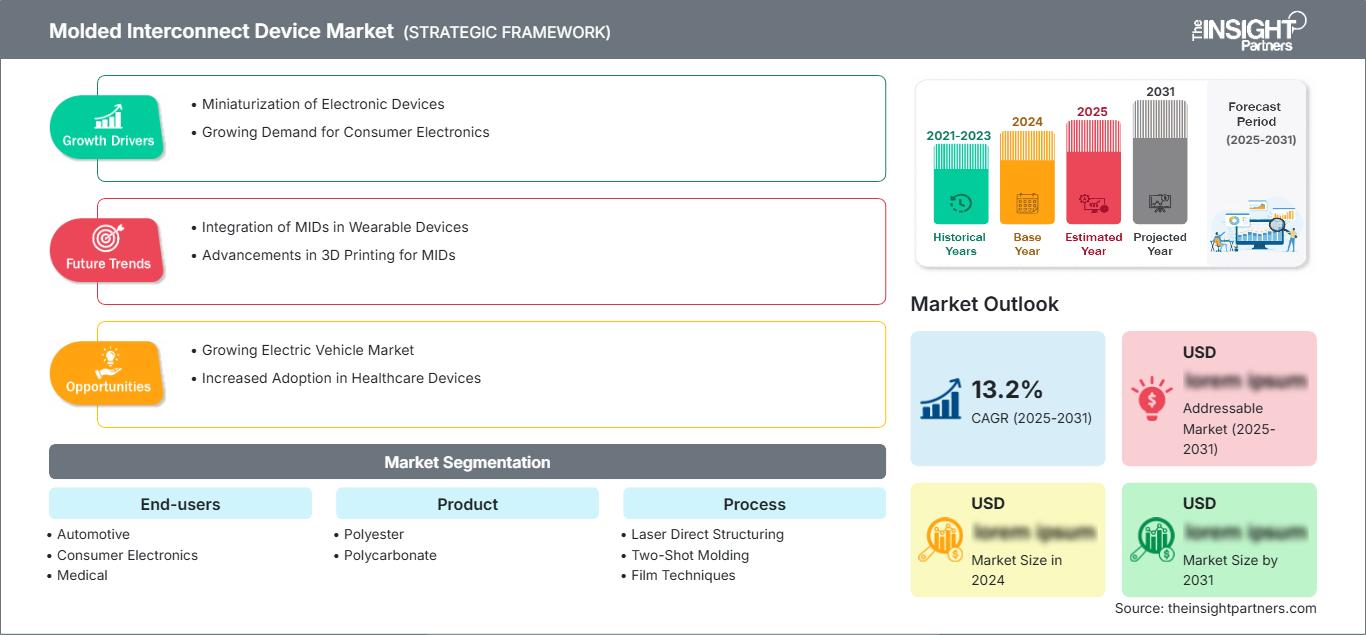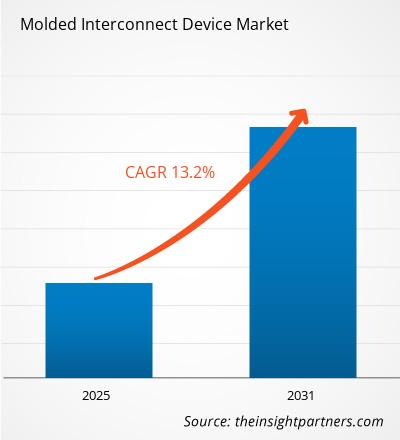Si prevede che il mercato dei dispositivi di interconnessione stampati registrerà un CAGR del 13,2% dal 2025 al 2031, con una dimensione del mercato in espansione da XX milioni di dollari nel 2024 a XX milioni di dollari entro il 2031.
Il rapporto è segmentato per prodotto (antenne e moduli di connettività, sensori, connettori e interruttori, sistemi di illuminazione e altri), utenti finali (settore automobilistico, elettronica di consumo, medicale, telecomunicazioni, militare e aerospaziale e altri), processo [strutturazione laser diretta (LDS), stampaggio a due fasi e tecniche di pellicola]. L'analisi globale è ulteriormente suddivisa a livello regionale e per i principali paesi. Il rapporto offre il valore in USD per l'analisi e i segmenti sopra indicati.
Scopo del rapporto
Il rapporto sul mercato dei dispositivi di interconnessione stampati di The Insight Partners mira a descrivere il panorama attuale e la crescita futura, i principali fattori trainanti, le sfide e le opportunità. Ciò fornirà spunti a vari stakeholder aziendali, come:
- Fornitori/produttori di tecnologia: per comprendere le dinamiche di mercato in evoluzione e conoscere le potenziali opportunità di crescita, consentendo loro di prendere decisioni strategiche informate.
- Investitori: per condurre un'analisi completa delle tendenze in merito al tasso di crescita del mercato, alle proiezioni finanziarie del mercato e alle opportunità esistenti lungo la catena del valore.
- Organismi di regolamentazione: per regolamentare le politiche e le attività di controllo nel mercato con l'obiettivo di ridurre al minimo gli abusi, preservare la fiducia degli investitori e sostenere l'integrità e la stabilità del mercato.
Segmentazione del mercato dei dispositivi di interconnessione stampati - Utenti finali
- Automotive
- Elettronica di consumo
- Medical
- Telecomunicazioni
- Militare e aerospaziale
Prodotto
- Poliestere
- Policarbonato
Processo
- Strutturazione diretta laser
- Stampaggio a due fasi
- Tecniche di pellicola
Geografia
- Nord America
- Europa
- Asia-Pacifico
- Sud e Centro America
- Medio Oriente e Africa
Potrai personalizzare gratuitamente qualsiasi rapporto, comprese parti di questo rapporto, o analisi a livello di paese, pacchetto dati Excel, oltre a usufruire di grandi offerte e sconti per start-up e università
Mercato dei dispositivi di interconnessione stampati: Approfondimenti strategici

-
Ottieni le principali tendenze chiave del mercato di questo rapporto.Questo campione GRATUITO includerà l'analisi dei dati, che vanno dalle tendenze di mercato alle stime e alle previsioni.
Fattori di crescita del mercato dei dispositivi di interconnessione stampati
- Miniaturizzazione dei dispositivi elettronici: la crescente domanda di dispositivi elettronici più piccoli ed efficienti è un fattore chiave per il mercato dei dispositivi di interconnessione stampati (MID). La tecnologia MID consente design miniaturizzati e compatti, riducendo le dimensioni complessive dei componenti in dispositivi come smartphone, dispositivi indossabili ed elettronica per autoveicoli, migliorandone così funzionalità e prestazioni e ottimizzando lo spazio.
- Crescente domanda di elettronica di consumo: la crescente domanda di elettronica di consumo, come smartphone, tablet e dispositivi per la domotica, sta dando impulso al mercato MID. I MID forniscono soluzioni efficienti ed economiche per l'interconnessione dei componenti elettronici in questi dispositivi, portando a tassi di adozione più elevati della tecnologia MID per progetti di elettronica di consumo avanzata.
Tendenze future del mercato dei dispositivi di interconnessione stampati
- Integrazione dei MID nei dispositivi indossabili: c'è una tendenza crescente all'integrazione dei MID nell'elettronica indossabile come smartwatch e fitness tracker. La capacità dei MID di supportare più interconnessioni in un fattore di forma ridotto li rende ideali per applicazioni indossabili, che richiedono sia compattezza che funzionalità, favorendone l'ampia adozione nel mercato della tecnologia indossabile.
- Progressi nella stampa 3D per i MID: la tecnologia di stampa 3D viene sempre più utilizzata per la produzione di dispositivi di interconnessione stampati. Ciò consente progetti più complessi, prototipazione rapida e costi di produzione ridotti, promuovendo l'innovazione nella produzione di MID. La tendenza all'utilizzo della stampa 3D nella fabbricazione di MID sta aprendo nuove possibilità nella progettazione e personalizzazione dei prodotti.
Opportunità di mercato per i dispositivi di interconnessione stampati
- Mercato dei veicoli elettrici in crescita: con l'espansione del mercato dei veicoli elettrici (EV), la domanda di soluzioni di interconnessione avanzate come i MID è in aumento. I MID offrono design leggeri, affidabili e compatti per i veicoli elettrici, rendendoli ideali per componenti come elettronica di potenza, sistemi di gestione delle batterie e sensori, creando significative opportunità nel settore automobilistico.
- Maggiore adozione nei dispositivi sanitari: i MID vengono sempre più integrati nei dispositivi medici grazie alle loro dimensioni ridotte, all'affidabilità e alla capacità di gestire interconnessioni complesse. Sono ideali per dispositivi come dispositivi medicali indossabili, apparecchiature diagnostiche e sistemi portatili di monitoraggio della salute, creando nuove opportunità per il mercato dei MID nel settore sanitario.
Approfondimenti regionali sul mercato dei dispositivi di interconnessione stampati
Le tendenze regionali e i fattori che influenzano il mercato dei dispositivi di interconnessione stampati durante il periodo di previsione sono stati ampiamente spiegati dagli analisti di The Insight Partners. Questa sezione illustra anche i segmenti e la geografia del mercato dei dispositivi di interconnessione stampati in Nord America, Europa, Asia-Pacifico, Medio Oriente e Africa, America Meridionale e Centrale.
Ambito del rapporto di mercato sui dispositivi di interconnessione stampati
| Attributo del rapporto | Dettagli |
|---|---|
| Dimensioni del mercato in 2024 | US$ XX million |
| Dimensioni del mercato per 2031 | US$ XX Million |
| CAGR globale (2025 - 2031) | 13.2% |
| Dati storici | 2021-2023 |
| Periodo di previsione | 2025-2031 |
| Segmenti coperti |
By Utenti finali
|
| Regioni e paesi coperti |
Nord America
|
| Leader di mercato e profili aziendali chiave |
|
Densità degli attori del mercato dei dispositivi di interconnessione stampati: comprendere il suo impatto sulle dinamiche aziendali
Il mercato dei dispositivi di interconnessione stampati è in rapida crescita, trainato dalla crescente domanda degli utenti finali, dovuta a fattori quali l'evoluzione delle preferenze dei consumatori, i progressi tecnologici e una maggiore consapevolezza dei vantaggi del prodotto. Con l'aumento della domanda, le aziende stanno ampliando la propria offerta, innovando per soddisfare le esigenze dei consumatori e sfruttando le tendenze emergenti, alimentando ulteriormente la crescita del mercato.

- Ottieni il Mercato dei dispositivi di interconnessione stampati Panoramica dei principali attori chiave
Punti di forza
- Copertura completa: il rapporto copre in modo completo l'analisi di prodotti, servizi, tipologie e utenti finali del mercato dei dispositivi di interconnessione stampati, fornendo un panorama olistico.
- Analisi degli esperti: il rapporto è compilato sulla base della conoscenza approfondita di esperti e analisti del settore.
- Informazioni aggiornate: il rapporto garantisce rilevanza aziendale grazie alla sua copertura di informazioni recenti e tendenze dei dati.
- Opzioni di personalizzazione: questo rapporto può essere personalizzato per soddisfare le esigenze specifiche del cliente e adattarsi in modo appropriato alle strategie aziendali.
Il rapporto di ricerca sul mercato dei dispositivi di interconnessione stampati può, quindi, aiutare a guidare il percorso di decodifica e comprensione dello scenario del settore e delle prospettive di crescita. Sebbene possano esserci alcune preoccupazioni valide, i vantaggi complessivi di questo rapporto tendono a superare gli svantaggi.
- Analisi storica (2 anni), anno base, previsione (7 anni) con CAGR
- Analisi PEST e SWOT
- Valore/volume delle dimensioni del mercato - Globale, Regionale, Nazionale
- Industria e panorama competitivo
- Set di dati Excel
Report recenti
Testimonianze
Motivo dell'acquisto
- Processo decisionale informato
- Comprensione delle dinamiche di mercato
- Analisi competitiva
- Analisi dei clienti
- Previsioni di mercato
- Mitigazione del rischio
- Pianificazione strategica
- Giustificazione degli investimenti
- Identificazione dei mercati emergenti
- Miglioramento delle strategie di marketing
- Aumento dell'efficienza operativa
- Allineamento alle tendenze normative






















 Ottieni un campione gratuito per - Mercato dei dispositivi di interconnessione stampati
Ottieni un campione gratuito per - Mercato dei dispositivi di interconnessione stampati